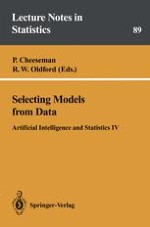1994 | OriginalPaper | Chapter
Inference, Intervention, and Prediction
Authors : Peter Spirtes, Clark Glymour
Published in: Selecting Models from Data
Publisher: Springer New York
Included in: Professional Book Archive
Activate our intelligent search to find suitable subject content or patents.
Select sections of text to find matching patents with Artificial Intelligence. powered by
Select sections of text to find additional relevant content using AI-assisted search. powered by
What can be predicted when the causal structure and the joint distribution among a set of random variables is known that cannot be predicted when only the joint distribution over the set of random variables is known? The answer is that with the former we can predict the effects of intervening in a system by manipulating the values of certain variables, while with only the latter we cannot. For example, if we know only the joint distribution of smoking and lung cancer, we cannot determine whether stopping people from smoking will reduce the rates of lung cancer. On the other hand, if we also know that smoking causes lung cancer (and that there is no common cause of smoking and lung cancer), we can predict that stopping smoking will reduce lung cancer, and by how much. As the quotations at the beginning of the article show, there is a debate within the statistics community about whether predicting the effects of interventions from passive observations is possible at all. In this paper we will describe some recent work for predicting the effects of interventions and policies given passive observations and some background knowledge. While addressing some of the claims just considered, the results we describe unify two traditions in statistics-one, beginning at least as early as Sewell Wright ([Wright 34]; [Simon 77]; [Blalock 61]; [Kiiveri 82]; [Wermuth 83]; [Lauritzen 84]; [Kiiveri 84]; [Wright 34]; [Glymour 87]; [Pearl 88]), connects directed acyclic graphs with probability distributions through constraints on conditional independence relations, while the other ([Neyman 35]; [Rubin 77]; [Rubin 78]; [PearVerm 91]) connects causal claims with “counterfactual distributions” and offers rules for predicting the distribution of a variable that will result if other variables are deliberately manipulated ([Rubin 77]; [Pratt 88]). We consider the following two cases.
